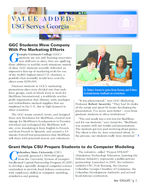VALUE ADDED: USG Serves Georgia
January 2009
GGC Students Wow Company With Pro Marketing Efforts
Georgia Gwinnett College (GGC) students are not only learning innovative new skill sets in class, they are applying those abilities in real-life work situations outside of class. GGC students recently delivered an impressive line-up of marketing tools for one of the world's highest-rated U.S. charities, a portfolio that normally would have cost the client some $200,000.
Nineteen students in GGC's marketing promotions class were divided into four taskforce groups, each of which went to work for MedShare International, a worldwide not-forprofit organization that obtains, sorts, packages and redistributes medical supplies that are surplused in the U.S., but in high demand in other countries.
The GGC teams created, wrote, and designed three new brochures for MedShare; created new signage for MedShare's headquarters in Decatur; reworked and redesigned the MedShare web site, even translating it from English to French, and from French to Spanish; and created a 13minute PowerPoint presentation that MedShare will share with potential donors and volunteers.
Dr. Robert Anservitz gives Brian Rainey and Althea Aschenbrenner feedback on a brochure.
"It was phenomenal," says GGC Marketing Professor Robert Anservitz. "They had 16 drafts of the script and spent 84 hours developing the presentation. I've never seen better even from graduate students at other institutions."
"The end result was a win-win for MedShare and for our students," says Anservitz. "MedShare was ecstatic with our results and presentations. The students got way past worrying about grades. The client is who we were concerned about. In the process, our students really were stretched." Q
Grant Helps CSU Prepare Students to do Computer Modeling
Columbus State University (CSU) recently garnered a $100,000 grant from the University System of Georgia's Intellectual Capital Partnership Program (ICAPP) to develop a specially designed computer science curriculum to provide local defense contractors with employees skilled in computer modeling, simulation and gaming.
The initiative, called "Project STEADI" (Simulation Technology Education Assisting the Defense Industry), represents a public-private partnership. Launched in 2007, the initiative includes CSU, Fort Benning, the Greater Columbus Georgia Chamber of Commerce, the Columbus Development Authority and several local defense contractors.
See "GRANT," p. 2...
VALUE ADDED USG Serves Georgia
KSU Statistics Professors Help Count Georgia's Homeless
More than 75,000 Georgians are homeless at some point during the year.
That was the key finding of the first statewide study on the homeless population conducted in 2008 by the Georgia Department of Community Affairs in collaboration with Kennesaw State University.
Using an innovative sampling methodology and predictive model developed by KSU statistics professors Jennifer Priestley and Victor Kane, the study estimated that there were more than 20,000 homeless people in Georgia one night last winter. The A. L. Burruss Institute of Public Service and Research at KSU conducted the census from the data collected at each of the localities doing the count.
A statistical methodology was selected because a physical count of homeless individuals across the state would not have been feasible. Instead, the homeless counts were estimated using a method known as cluster analysis, which forms groups or "clusters" of counties by demographic and economic characteristics as well as other variables obtained from the U.S. Census. Once the nine clusters were established and validated, homeless counts from one or two of the counties were obtained and applied to the other counties in the cluster.
The Georgia Department of Community Affairs is using the study data to determine the adequacy and effectiveness of the programs and services it provides. Q
GRANT Continued from P. 1
This is the second ICAPP program to start at CSU, which helped develop the economicdevelopment-through-partnerships concept in 1996 to provide computer-savvy employees for TSYS.
Project STEADI will build on a CSU computer science program that teaches students the theory, design and programming techniques required for producing games software. That knowledge is used in popular video games today, but also for training, simulations, modeling and games that have underlying uses, such as the Army recruitment game found online at www. americasarmy.com.
"We got a group together to brainstorm ideas," said Wayne Summers, chair of CSU's TSYS Department of Computer Science. "The defense industry said they were having a difficult time attracting people to help do simulations for them."
The problem quickly turned into an opportunity, with the burgeoning gaming program already in place, strong community support and existing campus resources.
John Fuller, a former chief of staff at Fort Benning, will lead the first phase of the project, which will involve working with local defense
Project STEADI enables soldiers to use simulators like this to learn how to drive the Stryker armored vehicle.
contractors to fully define the depth and breadth of their needs.
"It's a win-win proposition for everyone that's involved in it," Fuller said. His experience in the Army, as well as with local defense and homeland security contractors, has shown him the need in this area for employees with sophisticated computer skills.
Fuller estimates there are several hundred employees currently in the area with ties to this kind of technology and training. "Not only is the current demand for individuals with this talent growing, it will dramatically accelerate when the Armor School now at Fort Knox relocates to Fort Benning," he said. Q
